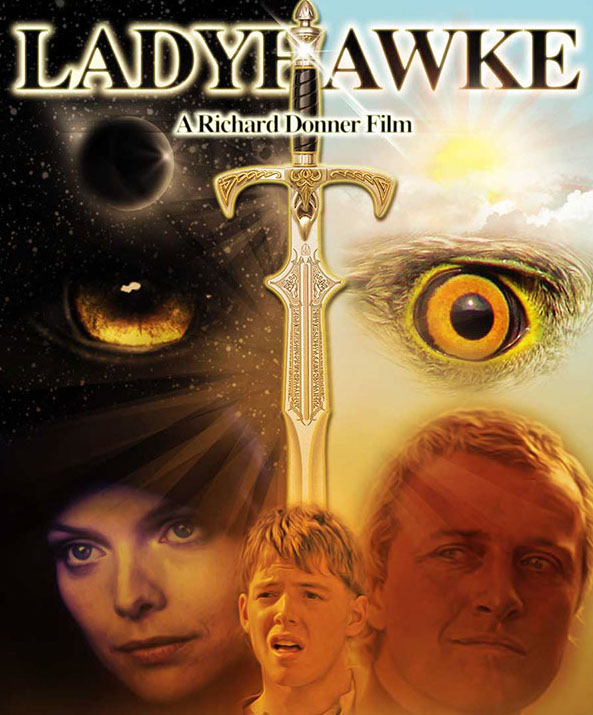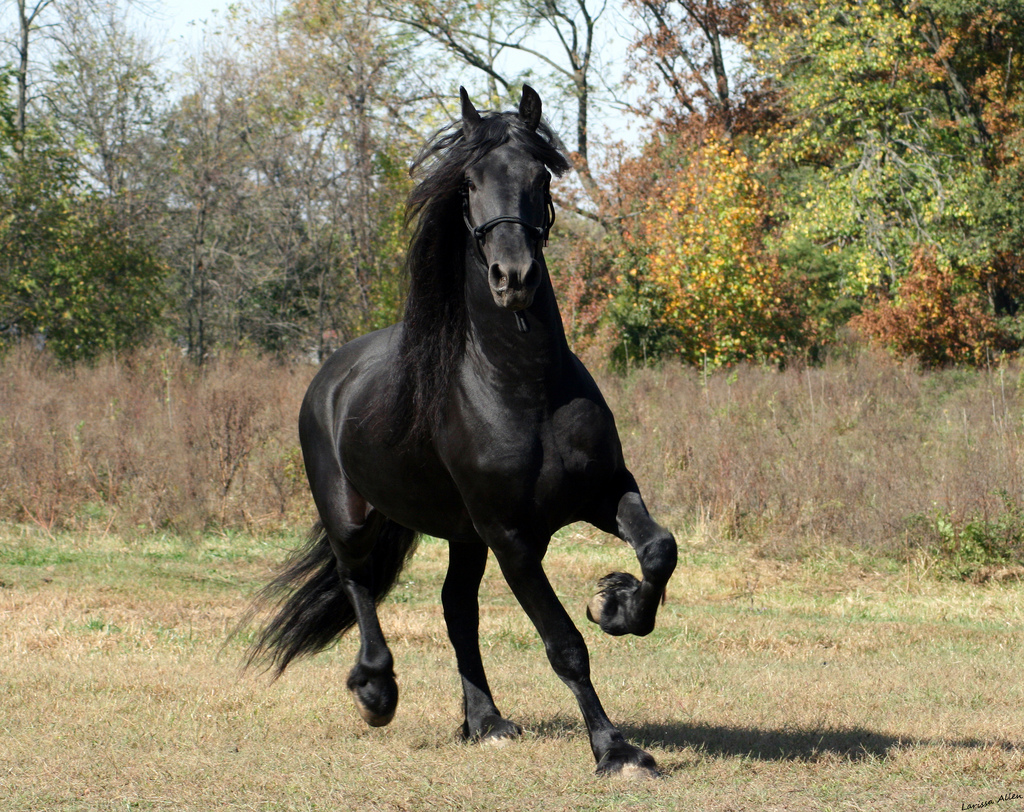RE:View Ladyhawke

Few things were more terrible than video rental night in the Eighties…
When it was her turn to pick.
Blockbuster night in the Eighties was fantastic when it was the guy’s turn to select the tape but when it was the girl’s, you, the young male Gen-Xer, knew you were facing an avalanche of overwhelming boredom. Chick flicks in the Eighties were an unclimbable mountain of ennui that you would nevertheless be required to try and scale.
The reason for all of this suck was the film company, Merchant Ivory. Purveyors of a nearly unending stream of slow-paced Edwardian and Victorian character studies, as well as movies where the sun was always setting on the empire that the sun never set on. The decade-long parade of tedious monotony speaks for itself.
Quartet
Heat and Dust
The Bostonians
A Room with a View
Maurice
The Deceivers (Okay, that one was pretty good. It was about an English officer infiltrating the Thug cult in India)
Slaves of New York
Howard’s End
The Ballad of Sad Cafe
However, the Eighties would occasionally throw the young Gen-X man a bone.
“Yeah, baby, that Helena Bonham Carter movie looks… Engaging. But what this thing? Ladyhawke?”
She shrugs, “Okay.”
Ladyhawke, was easily one of the best date night movies of that beloved decade. It had something for both of you. It had swordfights and few good jokes for the guy. And it had Rutger Hauer and Goliath the horse for the girl.

But does it hold up today?
Let’s take a look and find out.
Ladyhawke was one of those films that seemed like it was under a curse. It was years in development because something was always going wrong with some key element. This ended up saving this Richard Donner film from obscurity. The project started life as a Kurt Russel and Goldie Hawn movie. No, I’m not joking. They both ended up having to drop out because the preproduction took so long. Sean Penn and Dustin Hoffman had both been in talks to star as Gaston. Again, not joking.
A lot of what makes Ladyhawke work is the casting. Fate clearly saved it from some disastrous studio driven choices.
The movie opens with a sunset and the most Eighties soundtrack the Eighties ever produced.
This fantasy movie opened with violins and synth and an electric guitar riff, the composer was from The Alan Parson’s Project and it kinda showed. I was a bit indifferent to it when I first heard it but I love it now. Absolutely love it. It’s completely unique to this genre of film and really makes Ladyhawke stand out.
The film opens with Phillipe Gaston, a thief called the Mouse (not a bad name for this character) and he is rather anxious to skip an appointment. It’s with the hangman. He slips down a drain and into the sewers of the city of Aquila. While in the sewer he sees what appears to be a body floating towards him. Mouse prays aloud to the Father, promising that he will reform himself if the thing approaching him isn’t a body. Turns out, it isn’t. Then Mouse hears a Gregorian chant, so he sets off in that direction saying, “coming Lord.”
This scene sets the tone for the film, which is that it’s a redemption story. And not just for Mouse. Navarre, Isabeau, and Father Imperious all have redemption arcs to one degree or another. Goliath does not. He was clearly an aspirational horse.
So, Gaston escapes the city, and the Evil Bishop seems extremely upset by this. “No one escapes the dungeons of Aquila!” He wants the Mouse found and killed or there will be a new Captain of his Guard. The thuggish Captain Marquet takes off in pursuit, clearly wondering why he sticks around in a job where sooner or later he will get the ax.
As he is fleeing the city, Mouse stops to cut the purse strings on a soldier, stealing his money. He offers another prayer, “I know I promised Lord. But I know that you know what a weak-willed person I am.” Asking for forgiveness is easy, it’s the “go and sin no more” part most people have trouble with.
After a montage scene of a freezing Mathew Broderick escaping, he fetches up near a tavern and feels a need to boast of exploits. Bad idea as it turns out, as he is bragging about his escape to Captain Marquet and the Bishop’s guards. Broderick has a creditable action scene where he is slipping and eeling his way away from the guards. Today, it would be a fifteen-minute parkour scene that goes on too long. Broderick does his best in this scene, but the part really needed someone who could do physical comedy, (although I can’t think of any actor who could fit that bill in 1985).
Mouse is about to be executed, again when the guard assigned to that task gets hit with a crossbolt. Navarre, the hero protagonist of the picture has arrived.
At this point, I should mention the costuming. It was very much fantasy-based. I know enough about medieval dress that I can confidently say, it was from no recognizable period or place. There were European influences to be sure, but you couldn’t say that the costumes were from anyone time or place. Maybe that was deliberate. Navarre’s armor served no other purpose but to be decorative, but it certainly did that. It proved irresistible to the Eighties cosplay crowd.
This is Rutger Hauer’s other signature role (aside from Roy Batty). I have to say, the film wouldn’t be remembered today if he wasn’t in it. The Dutch actor brought an enigmatic, taciturn quality to the part that is required. He was able to carry himself as a military man with a heavy heart. In Europe, Hauer had been an equestrian at competition level, so the horsemanship presented no problem. And apparently, he was something of a born falconer. The first time he tried on the gauntlet, one of the hawks came screaming into land on it. Scared the hell out of everyone except him. He was cool as ice about it.
However, for thirteen-year-old girls in the audience, the real star was Goliath.

The horse, like its rider, was Dutch and was played by a Friesian stallion named Othello. Normally riding a stallion during filming is nuts, they don’t like other horses. But Othello was 19 years old at the time and Hauer had no trouble riding him. Donner selected the Friesian because it has an authentic medieval gait, formally called, “ambling.” Ladyhawke kicked off quite a craze for the breed.
Mouse and Navarre set off as adversaries thrown together by chance, they will naturally be fast friends by the end of the movie.
They run into a couple of extremely dirty peasants that had 1980s audience members chirping, “Keven there’s some lovely filth down here!”
The peasant tries to murder Phillipe in the night but is killed by a giant black wolf. Phillipe runs away and immediately into Isabeau (Michelle Pfeiffer was 27 at this time and pretty much at her peak hotness). Her looks lent themselves to an air of mystery that the part required.
At this point, Phillipe offers another prayer, that there were strange and magical things at work and that he didn’t want to be a part of them.
We learn that the evil Bishop and the evil Captain Marquet both have grudges against Navarre. After another fight scene, the hawk is hit with a cross-bolt, despite the Bishop’s orders not to do that. Navarre instructs Mouse to take the bird to Father Imperious (Leo McKern) who lives in a broken-down castle nearby. The sun sets and the hawk turns into Michelle Pfeiffer.
The audience has now worked out what’s going on. When the sun is up Isabeau is a hawk, when it goes down she turns into a human but Navarre turns into a wolf. Navarre and Isabeau are lovers, forever separated by twilight.
The exposition scene that follows is easily the weakest part of the movie. It is everything an exposition scene should not be, which is to say it is one huge background information dump that is explained to one person, while nothing else is going on in the scene. Imperious just sits there and tells Phillipe all about Isabeau’s background, all about her romance with Navarre, all about the Evil Bishop’s vile obsession with her. And all about the deal, the Bishop made with the devil to inflict the curse on the two lovers. The audience is told everything without any kind of visual aid, in what is fundamentally a visual medium. Worst scene in the movie.
The priest Imperious tells Isabeau and Navarre, (separately of course) that God has revealed to him a way to break the curse. In two days in Aquila, “there will be a day without a night and night without a day.” And if they appear before the Evil Bishop together the curse will break. Navarre tells, Imperious that he’s nuts and that he is sticking with his plan A, which is to go to Aquila and just kill the Bishop. They will still be cursed but at least the guy they hate will be dead.
Phillipe has been the audience’s POV character for this whole movie. We have been watching the story of Navarre and Isabeau through his eyes. So, we as the audience are sympathizing with Philippe’s frustration with his friends. He wants them to at least have a chance at happiness. And since Navarre and Isabeau can’t communicate directly, they have been using the Mouse to relay messages.
So, Phillipe tells Navarre, that Isabeau is totally down with Imperious’ plan and thinks they should try it. Mouse tells Isabeau the same bullshit story.
The rest is a normal built up in tension until the climax is reached. There is a solar eclipse in Aquila, Isabeau and Navarre both stand before the bishop after a prolonged fight scene. The curse is broken. The Evil Bishop tries to backstab Navarre and gets killed.
The End.
As I said at the start, casting is what took this film to the next level. This was Mathew Broderick’s first film after Wargames and is probably the one that landed him the job of Ferris Bueller. John Wood was wonderfully reptilian as the Evil Bishop of Aquila. Ken Hutchinson was the right level of thuggish for Captain Marquet. And Leo McKern rounded out the cast nicely as the repentant priest, Imperious.
The film was shot in Italy, although the Italians wouldn’t let them shoot in a church so they had to build their own medieval cathedral.
Does it hold up?
Well, yes and no.
The action scenes were fine for the mid-eighties, but they are hopelessly dated now. It was cool to see a broadsword duel with two actual broadswords. Richard Donner tried some interesting camera tricks but the action is just too slow for modern tastes.
So, if you are guy, Ladyhawke has slipped into dull.
But women still love it. My wife told me she had literally worn a hole in her cassette copy of the soundtrack. To this day women can’t decide who is the bigger draw for them, Rutger Hauer or the magnificent Friesian stallion, Goliath.
The tragic romance of true love under a curse still carries the film for them. It says something about the tale that when it came out everyone thought it was based on an actual medieval French legend. It wasn’t. It’s a wholly original story. We sure as hell don’t get those today.
And if you are a guy, it’s still way better than having to watch something from Merchant Ivory.
Okay, I’m done here.

